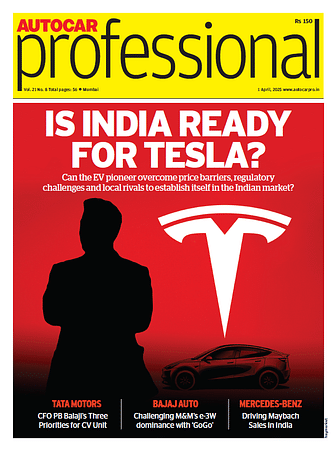Two Hemispheres, Two Roads - India’s Auto Leaders Decode the Global North–South Divide in Clean Mobility
At the Future of Powertrains Conclave, Toyota and Stellantis leaders underscore the importance of regional strategies in the shift to net zero.
As the global auto industry accelerates toward decarbonisation, a clear divide is forming. While the Global North pursues rapid electrification fueled by policy mandates, advanced infrastructure, and generous incentives, the Global South is carving out a different path—one rooted in practicality, energy diversity, and local realities.
Speaking at the Future of Powertrains Conclave in Chennai, co-hosted by Autocar Professional and Guidance Tamil Nadu, two of India’s leading automotive voices—Vikram Gulati, Country Head and Executive Vice President – Corporate Affairs and Governance at Toyota Kirloskar Motor, and Shailesh Hazela, Managing Director of Stellantis India— outlined why emerging economies require region-specific clean mobility solutions.
“The future is electrified—but not electric alone,” said Gulati, summarizing India's expected approach. “Every market has its journey. What matters is the collective shift away from fossil fuels toward technologies that are sustainable, scalable, and suited to the local context."
Hazela agreed, highlighting both the technological and geographical dimensions of the divide.
“If we divide the north versus the south hemisphere, the north is going to be faster in adopting EVs versus the south, which will be like flex fuel, ICE, which includes petrol, diesel, and hydrogen—all will coexist in the southern hemisphere.”
While battery electric vehicles (BEVs) dominate the clean mobility narrative in regions like Europe, the US, and East Asia, countries in the Global South are leaning into a multi-energy approach—embracing internal combustion engines (ICE), strong hybrids, plug-in hybrids (PHEVs), ethanol blends, CNG, and even hydrogen.
This, as both executives noted, is not a compromise—it’s a response to infrastructure limitations, affordability constraints, and consumer readiness.
“There is a clear trend globally towards electrification,” said Gulati. “But there is also geographical diversity in how that transition is playing out.”
Brazil: The Biofuel Pioneer
In Brazil, ethanol has long been at the heart of its clean fuel strategy. Over 80% of vehicles sold today are flex-fuel compatible, meaning they can run on E100 ethanol or any blend of ethanol and gasoline. The country’s fuel distribution infrastructure is already tailored to ethanol, and its sugarcane-based biofuel industry supports both rural livelihoods and national energy security.
The government has further supported this initiative with RenovaBio, a national biofuels policy that offers carbon credits and incentivizes the production of sustainable fuels. Brazil’s model is a widely recognized example of large-scale biofuel adoption.
“If you look at how the Global South is moving—for example, Latin America and Brazil—the clear shift is towards biofuels. In Southeast Asia, the shift is again towards sustainability, but the offtake of strong hybrids and PHEVs is much more aggressive,” said Gulati.
Southeast Asia: Hybrids Lead the Charge
In Southeast Asia, particularly in markets like Thailand, Indonesia, and Vietnam, strong hybrids and PHEVs are gaining ground more rapidly than BEVs. This is due to lower upfront costs, improved fuel efficiency, and the lack of adequate charging infrastructure in both urban and rural areas.
Thailand has introduced a tax structure that heavily favors hybrids and flex-fuel vehicles. Indonesia is working on promoting EV adoption while simultaneously expanding its ethanol and biodiesel programs. Both countries are also focused on localizing battery and component production rather than importing entire EV supply chains.
India: Building a Multi-Fuel Future
India is developing its version of this multi-fuel roadmap. Ethanol blending has already reached E20 levels nationwide, displacing 20% of gasoline from the energy mix. The recent Auto Expo featured leading OEMs showcasing flex-fuel vehicles, while the government has committed to achieving full flex-fuel readiness in new cars by 2025–26.
CNG usage is also expanding rapidly, with over 17,500 CNG stations planned by 2030. More importantly, Compressed Biogas (CBG) is being integrated with CNG networks to improve sustainability. At the same time, India’s FAME-II policy and PLI schemes are supporting the EV ecosystem, particularly in the two- and three-wheeler segments.
“We’re already at E20. That means 20% of the gasoline is already being displaced,” Gulati said.
This region-specific mix is already shaping product and manufacturing strategies. For Stellantis, India—particularly its Hosur facility in Tamil Nadu—is emerging as a global hub for gearboxes and engines, many of which are exported to Europe. As Western OEMs phase out ICE platforms, India may remain a key ICE manufacturing hub as other markets transition. “India would be the last country standing when it comes to ICE. And we will be the last producer—including Tamil Nadu should be the last one to produce the last ICE in India,” Hazela noted.
Yet managing this technological diversity won’t be easy. Hazela called it an “engineer’s challenge”—balancing internal manufacturing complexity with a seamless customer experience.
“Every one of these transitions will have its own pace. And we are going to see, which I call an engineer's challenge, how to continue living with multi-energy platforms because policies are shifting, leading to adoption in different countries at varying levels and speeds,” Hazela added.
The implications for India are clear. Over the next decade, its mobility ecosystem is expected to feature a broader range of technologies than most developed markets. EVs will rise, but so will ethanol, CNG, flex-fuels, hybrids, and hydrogen.
This story extends well beyond India—it offers a template for the Global South, where countries are seeking affordable, adaptable, and scalable clean mobility solutions.
“This would be, I would say, a real challenge for us, as an automaker—to create value for the customer without overburdening them with the complexity that we have internally,” Hazela said.
The message from Chennai was unmistakable: the Global South must pursue its own net zero pathway, grounded in pragmatism, not prescription. The future won’t be uniform—it will be multi-technology, multi-speed, and locally contextual.
RELATED ARTICLES
TVS Motor Expands EV Presence in Southeast Asia with ION Mobility Integration
As part of this development, TVS Motor (Singapore) Pte Ltd, a wholly owned subsidiary of TVSM, has acquired select asset...
Hyva to Showcase New Transport and Handling Solutions at BAUMA 2025
Hyva will present a range of transport, hydraulic, and digital solutions at BAUMA 2025, focusing on safety, efficiency, ...
Valeo Expands Manufacturing Capabilities in Pune to Boost EV Offerings
Valeo enhances its manufacturing operations in Pune with advanced assembly lines to support the production of integrated...






 By Ketan Thakkar & Prerna Lidhoo
By Ketan Thakkar & Prerna Lidhoo
 04 Apr 2025
04 Apr 2025
 1456 Views
1456 Views





 Arunima Pal
Arunima Pal


 Sarthak Mahajan
Sarthak Mahajan


